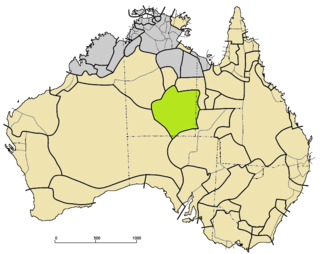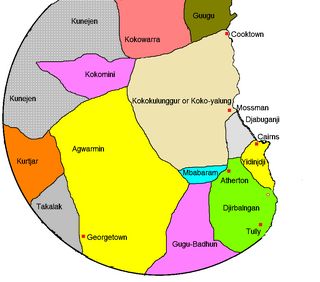
Dyirbal is an Australian Aboriginal language spoken in northeast Queensland by the Dyirbal people. In 2016, the Australian Bureau of Statistics reported that there were 8 speakers of the language. It is a member of the small Dyirbalic branch of the Pama–Nyungan family. It possesses many outstanding features that have made it well known among linguists.

The Indigenous languages of Australia number in the hundreds, the precise number being quite uncertain, although there is a range of estimates from a minimum of around 250 up to possibly 363. The Indigenous languages of Australia comprise numerous language families and isolates, perhaps as many as 13, spoken by the Indigenous peoples of mainland Australia and a few nearby islands. The relationships between the language families are not clear at present although there are proposals to link some into larger groupings. Despite this uncertainty, the Indigenous Australian languages are collectively covered by the technical term "Australian languages", or the "Australian family".
Guugu Yimithirr, also rendered Guugu Yimidhirr, Guguyimidjir, and many other spellings, is an Australian Aboriginal language, the traditional language of the Guugu Yimithirr people of Far North Queensland. It belongs to the Pama-Nyungan language family. Most of the speakers today live at the community of Hope Vale, about 46 kilometres (29 mi) from Cooktown. However, as of June 2020 only about half of the Guugu Yimithirr nation speak the language. As such, efforts are being made to teach it to children. Guugu Yimithirr is the source language of the word kangaroo.

Prior to the arrival of Europeans, Australian Aboriginal languages had been purely spoken languages, and had no writing system. On their arrival, Latin script became a standard for transcription of Australian Aboriginal languages, but the details of how the sounds were represented has varied over time and from writer to writer, sometimes resulting in a great many variant spellings of the same word or name.
Yalarnnga is an extinct Australian Aboriginal language of the Pama–Nyungan language family, that may be related to the Kalkatungu language. It was formerly spoken by the Yalarnnga people in areas near the Gulf of Carpentaria the towns of Dajarra and Cloncurry in far northwestern Queensland. The last native speaker died in 1980. It is a suffixing agglutinative language with no attested prefixes.
Nyikina is an Australian Aboriginal language of Western Australia, spoken by the Nyigina people.

Arrernte or Aranda or sometimes referred to as Upper Arrernte, is a dialect cluster in the Arandic language group spoken in parts of the Northern Territory, Australia, by the Arrernte people. Other spelling variations are Arunta or Arrarnta, and all of the dialects have multiple other names.
The Manbarra, otherwise known as the Wulgurukaba, are Aboriginal Australian people, and the traditional custodians of the Palm Islands, Magnetic Island, and an area of mainland Queensland to the west of Townsville.

Wulguru, is an Australian Aboriginal language, now extinct, that was spoken by the Wulgurukaba people around the area around present day Townsville, Queensland, on the east coast of Australia. The range of Wulguru dialects known to have been around the area include two varieties mentioned from Palm Island, two from the Cleveland Bay area, and various dialects from Townsville.
The Ndjébbana language, also spelt Djeebbana and Ndjebanna and also known as Kunibidji, is a Burarran language spoken by the Gunavidji (Ndjebbana) people of North-central Arnhem Land in the Northern Territory of Australia.

Worrorra, also written Worora and other variants, and also known as Western Worrorran, is a moribund Australian Aboriginal language of northern Western Australia. It encompasses a number of dialects, which are spoken by a group of people known as the Worrorra people.
Turrbal is an Aboriginal Australian language of the Turrbal people of the Brisbane area of Queensland.
The Lamalama language, also known by the clan name Mbarrumbathama (Austlang) or Mba Rumbathama, formerly known as Lamu-Lamu or Lama-Lama, is a Paman language of Queensland, Australia. Lamalama is one of four languages once spoken by the Lamalama people, the others being Morrobolam (Umbuygamu), Mbariman-Gudinhma, and Umpithamu.
Jandai is an extinct Australian Aboriginal language of the Quandamooka people who live around the Moreton Bay region of Queensland. Other names and spellings are Coobenpil; Djandai; Djendewal; Dsandai; Goenpul; Janday; Jendairwal; Jundai; Koenpel; Noogoon; Tchandi. Traditionally spoken by members of the Goenpul people, it has close affinities with Nunukul language and Gowar language. Today now only few members still speak it.
Gubbi Gubbi, also (incorrectly) spelt Kabi-Kabi/, is a language of Queensland in Australia, formerly spoken by the Gubbi Gubbi people of South-east Queensland. The main dialect, Gubbi Gubbi, is extinct, but there are still 24 people with knowledge of the Butchulla dialect, a language spoken by the Butchulla people of K'gari.
Warrgamay is an extinct Australian Aboriginal language of northeast Queensland. It was closely related to Dyirbal.
Ayabadhu (Ayapathu), or Badhu, is an extinct Australian Aboriginal language of the Paman family spoken on the Cape York Peninsula of North Queensland, Australia by the Ayapathu people. The Ayabadhu language region includes the Cook Shire and the areas around Coen and Port Stewart.

Wamin, also known as Agwamin or Ewamian, is an Australian Aboriginal language of North Queensland spoken by the Ewamian people. Wamin was traditionally spoken in the Etheridge region, in the areas around Einasliegh, Georgetown, and Mount Surprise.

Darumbal, also spelt Dharambal, is an Australian Aboriginal language of Queensland in Australia declared extinct. It was spoken in the Rockhampton area of Queensland, as well as on the Capricorn Coast, Southern Great Keppel Island and Yeppoon islands. Dialects were Guwinmal, Karunbara, Rakiwara, and Wapabura. It is classified with Bayali as a Kingkel language, but the two are not close, with a low 21% shared vocabulary. Indeed, Angela Terrill states that "there is no evidence on which to base a claim of a low-level genetic group including Dharumbal with any other language".

The Kokatha language, also written Kukatha, Kokata, Gugada, and other variants, and also referred to as Madutara, Maduwonga, Nganitjidi, Wanggamadu, and Yallingarra and variant spellings of these, is an Australian Aboriginal language of the Western Desert group traditionally spoken by the Kokatha people, whose traditional lands are in the western part of the state of South Australia, north of the Wirangu people.
 This Wikipedia article incorporates text from Nyawaygi published by the State Library of Queensland under CC BY licence , accessed on 30 May 2022.
This Wikipedia article incorporates text from Nyawaygi published by the State Library of Queensland under CC BY licence , accessed on 30 May 2022. 







